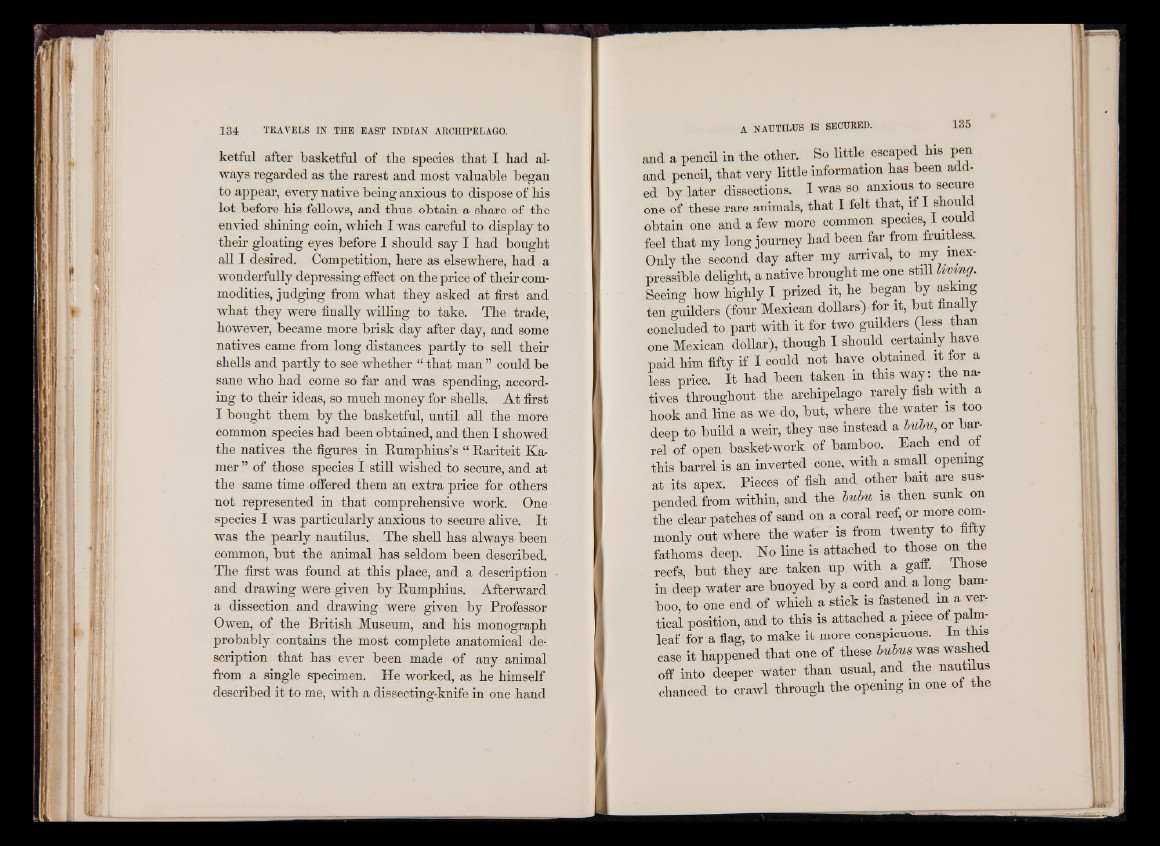
ketful after basketful of the species tkat I bad always
regarded as tbe rarest and most valuable began
to appear, every native being anxious to dispose of bis
lot before bis fellows, and tbus obtain a sbare of tbe
envied sbining coin, wbicb I was careful to display to
tbeir gloating eyes before I should say I bad bought
all I desired. Competition, here as elsewhere, bad a
wonderfully depressing effect on tbe price of tbeir commodities,
judging from what they asked at first and
what they were finally willing to take. The trade,
however, became more brisk day after day, and some
natives came from long distances partly to sell tbeir
shells and partly to see whether “ that man ” could be
sane who bad come so far and was spending, according
to tbeir ideas, so much money for shells. At first
I bought them by the basketful, until all tbe more
common species bad been obtained, and then I showed
tbe natives tbe figures in Rumphius’s “ Rariteit Ka-
mer ” of those species I still wished to secure, and at
tbe same time offered them an extra price for others
not represented in that comprehensive work. One
species I was particularly anxious to secure alive. It
was tbe pearly nautilus. Tbe shell has always been
common, but tbe animal has seldom been described.
Tbe first was found at this place, and a description
and drawing were given by Rumpbius. Afterward
a dissection and drawing were given by Professor
Owen, of tbe British Museum, and bis monograph
probably contains tbe most complete anatomical description
that has ever been made of any animal
from a single specimen. He worked, as be himself
described it to me, with a dissecting-knife in one band
and a pencil in tbe other. So little escaped bis pen
and pencil, that very little information has been added
by later dissections. I was so anxious to secure
one of these rare animals, that I felt that, if I should
obtain one and a few more common species, I could
feel that my long journey bad been far from fruitless.
Only tbe second day after my arrival, to m y inexpressible
delight, a native brought me one still liming.
Seeing bow highly I prized it, be began by asking
ten guilders (four Mexican dollars)-for it, but finally
concluded to part with it for two guilders (less than
one Mexican dollar), though I should certainly have
paid him fifty if I could not have obtained it for a
less price. It bad been taken in this way: the natives
throughout tbe archipelago rarely fish with a
book and line as we do, but, where tbe water is too
deep to build a weir, they use instead a bubu, or barrel
of open basket-work of bamboo. Each end of
this barrel is an inverted cone, with a small opening
at its apex. Pieces of fish and other bait are suspended
from within, and tbe hubu is then sunk on
tbe clear patches of sand on a coral reef, or more commonly
out where tbe water is from twenty to fifty
fathoms deep. Ho line is attached to those on the
reefs, but they are taken up with a gaff, lhose
in deep water are buoyed by a cord and a long bamboo,
to one end of which a stick is fastened in a vertical
position, and to this is attached a piece of palm-
leaf for a flag, to make it more conspicuous. In this
case it happened that one of these bubus was washed
off into deeper water than usual, and the nautilus
chanced to crawl through the opening m one of the